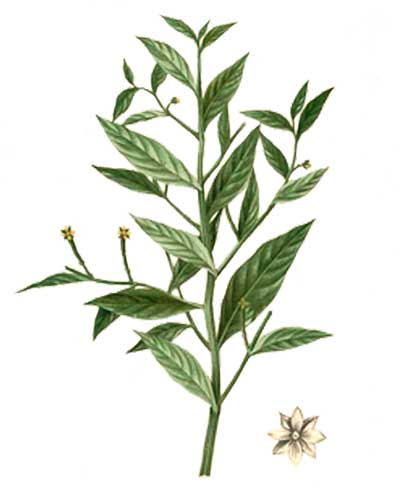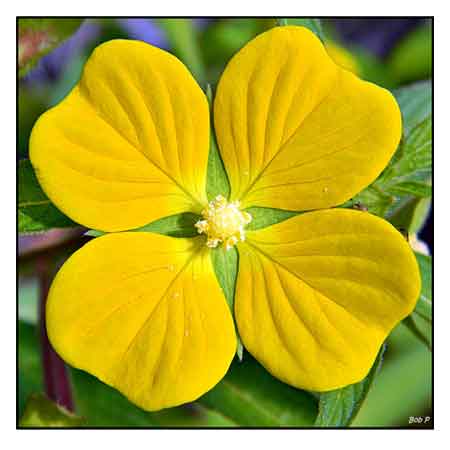
Family • Onagraceae
Malapako
Ludwigia octovalvis (Jacq.) P.H.Raven
PRIMROSE YELLOW
Mao cao long
| Scientific names | Common names |
| Jussiaeae octovalvis (Jacq.) P.H.Raven | Balansuit (Bag.) |
| Jussiaeae octovalvis (Jacq.) Sw. | Malapako (Bik.) |
| Oenothera octovalvis Jacq. | Pachar-pachar (Sul.) |
| Accepted infraspecifics | Palangdisin (Ig.) |
| Jussiaeae octovalvis subsp. brevisepala (Brenan) P.H.Raven | Talangkau (Ilk.) |
| Jussiaeae octovalvis subsp. octovalvis | Tayilakton (Tag.) |
| Jussiaeae octovalvis subsp. sessiliflora (Micheli) P.H.Raven | Tubong-talapang (Bik.) |
| False primrose (Engl.) | |
| Mexican primrose-willow (Engl.) | |
| Primrose willow (Engl.) | |
| Ludwigia octovalvis (Jacq.) P.H.Raven is an accepted name. KEW: Plants of the World Online | |
| Other vernacular names |
| ASSAMESE: Bon jalakia. |
| BENGALI: Ban lavanga. |
| CHINESE: Cao li jin chai, Cao long, Shui ding xiang, Zhen tong ci, Shui long, Shui yang cao, Sao guo cao. |
| HINDI: Ban long, Banlunga. |
| INDIA: Panijalokia, Kabo kaji. |
| INDONESIAN: Cacabean, salah nyowo, lakum air. |
| KANNADA: Kauakula. |
| MALAYALAM: Kattukarayamapu, Kattukarayamboov, Kattukarayamb, Neergrambo. |
| MALAYSIA: Buyang samalam, Lakom ayer, Pujang malam. |
| MARATHI: Pan lavang. |
| NIGERIAN: Shaashaatau. |
| SANSKRIT: Bhu lavangah (Bhoolvananga). |
| SPANISH: Yerba de jicotea. |
| TAMIL: Kattukkirampu, Nirrkrambu. |
| TELUGU: Nirubaccala. |
| THAI: Thian nam, yaa raknaa. |
| VIETNAMESE: Rau murong dung, Mu[uw][ow]ng d[aas]t. |
| WEST AFRICAN: Serer perte, Loko lamingi, Julo n'dingo. |
Updated October 2022 / March 2018 / July 2016
![]()
 |
PHOTOS / ILLUSTRATIONS |
| IMAGE SOURCE: Photograph / Ludwigia octovalvis.jpg / Vinyaraj / 2013 / Creative Commons Attribution-Share Alike 4.0 / click on photo to see source image / Wikipedia |
| OTHER IMAGE SOURCE / Public Domain / File:Jussiaea sp Blanco2.322-original.png / Flora de Filipinas / 1880 - 1883 / Francisco Manuel Blanco (O.S.A) / Wikimedia Commons |
| OTHER IMAGE SOURCE: Photograph / Ludwigia octovalvis / Bob Peterson / 2011 / Creative Commons Attribution-Share Alike 2.0 Generic / click on photo to see source image / Wikimedia Commons |
| Additional
Sources and Suggested Readings (1) Ludwigia octovalvis (Jacq.) P. H. Raven / Catalogue of Life, China (2) Evaluation of anti-pyretic potential of Jussiaea suffruticosa L. extract in rats / T. Murugesan, S.C. Mandal, T. Bhakta, J. Das et al / http://dx.doi.org/10.1016/S0944-7113(00)80008-2, (3) Evaluation of antidiarrhoeal profile of Jussiaea suffruticosa Linn. extract in rats / T Murugesan, Lopamudra Ghosh, Kakali Mukherjee et al / Phytotherapy Research, Volume 14, Issue 5, pages 381–383, August 2000 / DOI: 10.1002/1099-1573(200008)14:5<381::AID-PTR590>3.0.CO;2-P (4) Studies on the chemical constituents in herb of Ludwigia octovalvis / Yan J, Yang XW. / Zhongguo Zhong Yao Za Zhi. 2005 Dec; 30(24): pp 1923-6. (5) Toxicological evaluation of 80% methanol extract of Ludwigia octovalvis (Jacq.) P.H. Raven leaves (Onagraceae) in BALB/c mice. / Kadum Yakob H, Manaf Uyub A, Fariza Sulaiman S. / J Ethnopharmacol. 2012 Aug 1;142(3):663-8. / doi: 10.1016/j.jep.2012.05.035. Epub 2012 Jun 13. (6) Antioxidant and Antibacterial Activity of Ludwigia octovalvis on Escherichia coli O157:H7 and Some Pathogenic Bacteria / Haidar Kadum Yakob, Shaida F. Sulaiman and Abd M. Uyub / World Applied Sciences Journal 16 (1): 22-29, 2012 (7) Willow primrose / Common names / Flowers of India (8) Chlorophyll a, an active anti-proliferative compound of Ludwigia octovalvis, activates the CD95 (APO-1/CD95) system and AMPK pathway in 3T3-L1 cells. / SJ Wu, LT Ng, GH Wang, YJ Huang, JL Chen, FM Sun / Food Chem Toxicol (2009) 0: (10) Phytochemical and antioxidant activities of ethno- medicinal plants used by fisher folks of Chilika lagoon for Indigenous Phytotherapy / Sikha Mandal, Jnanendra Rath / Journal of Pharmacognosy and Phytochemistry 2015; 3(5): 55-65 (11) Evaluation of farmer knowledge and their composition on the use of non-cultivated plants for livestock feed in the Mekong delta of Vietnam / Nguyen Nhut Xuan Dung, Britta Antonsson-Ogle and P Udén / FAO Corporate Document Repository (12) Antidiabetic plants used in Thoubal district of Manipur, Northeast India / Mohd Habibullah Khan & P S Yadava / Indian Journal of Traditional Knowledge, Vol 9 (3), July 2010, pp 510-514. (13) Plant Remedies Practiced by Keffi People in the Management of Dermatosis / Alqasim Abdullahi Mustapha*, Gabriel Owuna, Is-Haq Ishaq Uthman / Journal of Medicinal Plants Studies, 2013, Volume 1, Issue 5 (14) In Vitro Screening of Medicinal Plants Used in Mexico as Antidiabetics with Glucosidase and Lipase Inhibitory Activities / Guillermo Ramírez, Miguel Zavala, Julia Pérez, and Alejandro Zamilpa / Evidence-Based Complementary and Alternative Medicine, Volume 2012 (2012) / http://dx.doi.org/10.1155/2012/701261 (15) Ethnobotanical perspective of antimalarial plants: traditional knowledge based study / Abdul Qayum, Rakesh Arya and Andrew M. Lynn / BMC Research Notes 20169:67 / DOI: 10.1186/s13104-015-1827-z (16) Ludwigia octovalvis / Plants of Saint Lucia (17) Ludwigia octovalvis: medicinal uses / PROTA4U (18) Evaluation of Diuretic Activity of Jussiaea Suffruticosa Linn. / R.Mythreyi, N.Rajkumar* and E.Sasikala / Maharaji College of Pharmacy, Besant Nagar, Chennai-90 and Central Research Institute for Siddha, Arumbakkam, Chennai-106 / PharmacologyOnLine (19) Evaluation of Diuretic Potential of Jussiaea suffruticosa Linn. extract in Rats / T. Murugesan, L. Manikandan, K. B. Suresh, M. Pal, and B.P. Saha / Indian Journal of Pharmaceutical Sciences, Mar-Apr 2000 (20) Antitussive Medicinal Herbs - An Update Review / G. R. Saraswathy*, R. Sathiya, J. Anbu, E. Maheswari / International Journal of Pharmaceutical Sciences and Drug Research 2014; 6(1): 12-19 (21) The anti-aging effects of Ludwigia octovalvis on Drosophila melanogaster and SAMP8 mice / Wei-Sheng Lin, Jun-Yi Chen, Jo-Chiao Wang, Liang-Yu Chen et al / Age (Dordr), Apr 2014; 36(2): pp 689-703 / doi: 10.1007/s11357-013-9606-z (22) In Vitro Screening of Medicinal Plants Used in Mexico as Antidiabetics with Glucosidase and Lipase Inhibitory Activities / Guillermo Ramirez, Miguel Zavala, Julia Perez, and Alejandro Zamilpa / Evidence-Based Complementary and Alternative Medicine, Vol 2012 (2012) / http://dx.doi.org/10.1155/2012/701261 (23) Three New Oleanane-Type Triterpenes from Ludwigia octovalvis with Cytotoxic Activity against Two Human Cancer Cell Lines / Chi-I Chang, Ching-Chuan Kuo, Jang-Yang Chang, and Yueh-Hsiung Kuo / J. Nat. Prod., 2004, 67 (1), pp 91–93 / DOI: 10.1021/np030267m (24) Phytotoxicity and Uptake of Arsenic by Ludwigia octovalvis in a Pilot Reed Bed System / Titah Harmin Sulistiyaning, Abdullah Siti Rozaimah Sheikh, Mushrifah Idris, Anuar Nurina, Basri Hassan, and Mukhlisin Muhammad / Environmental Engineering Science, Vol 31, No 2 (2013) / https://doi.org/10.1089/ees.2013.0207 (25) Ethnomedical knowledge of plants and healthcare practices among the Kalanguya tribe in Tinoc, Ifugao, Luzon, Philippines / Teodora D Balangcod* & Ashlyn Kim D Balangcod / Indian Journal Of Traditional Knowledge, Vol. 10(2), April 2011, pp. 227-238 (26) Immune-stimulating properties of 80% methanolic extract of Ludwigia octovalvis against Shiga toxin-producing E. coli O157:H7 in Balb/c mice following experimental infection / Haidar Kadum Yakob, Abd. Manaf Uyub, Shaida Fariza Sulaiman / Journal of Ethnopharmacology 172 (2015): pp 30-37 (27) Ethnomedicinal Plants Used by the ethnic Communities of Tinsukia District of Assam, India / Jitu Buragohain* / Recent Research in Science and Technology 2011, 3(9): pp 31-42 (28) Ludwigia octovalvis / KEW: Plants of the World Online (29) Ludwigia octovalvis (primrose willow) / CABI: Invasive Species Compendium (30) Identification of Digestive Enzyme Inhibitors from Ludwigia octovalvis (Jacq. )PH Raven / Dulce Morales, Guillermo Ramirez, Alejandro Zamilpa et al / Evidence-Based Complementary and Alternative Medicine, Volume 2018; Article ID 8781352 / DOI: 10.1155/2018/8781352 (31) Ludwigia octovalvis extract improved glycemic control and memory performance in diabetic mice / Wei-Sheng Lin, Kung-Hsin Lo, Pei-Yu Wang et al / Journal of Ethnopharmacology / DOI: 10.1016/j.jep.2017.06.044 (32) Evaluation of the Alpha-Glucosidase Inhibitory Activity of Endophytic Bacteria Extracts Isolated from Ludwigia octovalvis (Jacq.) P.H. Raven (Onagraceae) / Ngene Jean Pierre, Ngoule Charles Christian, Etame-Loe Gisele et al / Saudi Journal of Medical and Pharmaceutical Sciences, 2022; 8(2): pp 70-75 / eISSN: 2413-4910 / pISSN: 2413-4929 / DOI: 10.36348/sjmps.2022.v08i02.005 |
• |
DOI: It is not uncommon for links on studies/sources to change. Copying and pasting the information on the search window or using the DOI (if available) will often redirect to the new link page. (Citing and Using a (DOI) Digital Object Identifier) |
| List of Understudied Philippine Medicinal Plants |
• |
 |


 Distribution
Distribution
